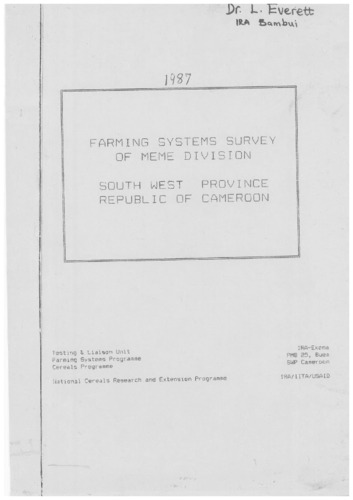Farming systems survey of Meme division south west province Republic of Cameroon
Abstract
Background: In order to help IRA researchers on and off station direct their work more towards the potentials and needs of food-crop farmers in the South West and Littoral, the TLU at Ekona is undertaking a series of farming systems surveys. The series began in 1986.
Objectives: To provide useful information to IRA breeders and agronomists, to MINAGRI extension workers and planners, and to the TLU for its on-farm trial program.
Methods: Preliminary analysis of Meme Division soils, climate and demographic data was followed by a formal survey of 120 farmers in 24 villages of all but one of the most populated ecozones, coupled with qualitative description of one to two fields per village. Statistical and qualitative results were combined to produce a descriptive report based on differences by ecozone and field type.
Results and Discussion: Meme farmers grow food crops both for commercial and subsistence purposes, and at least a third of the production of every major crop is sold. Despite this, the technological level is quite low. Major inputs are still land and labour; purchased inputs are limited almost entirely to labour. Chemicals and tools are scarce in quality as well as quantity. Improved planting materials are almost non-existence, although much desired. Crop protection chemicals and tools are in demand, but not fertilizers.
Meme crops in order of economic importance are plantains, yams, cassava, cocoyams, taro, maize, bananas, groundnuts, egusi melons, beans, and potatoes. Ordered by food energy, maize rises to third place and cassava to first. Cocoyams are low in importance only because the root rot is devastating yields. Plantain weevils and nematodes and maize stem borers and storage weevils are the other serious pest/disease problems meriting focussed research. Varietal improvement in maize will increase the already existing marketing problems unless storage improvements are concurrent. The best existing markets are for plantains, cocoyams and yams (local and export) and cassava (local only).
Priority zones for agricultural research are the area stretching east-west from Kumba town and the area around the Supe Escarpment. The former zone is land-scarce and is developing problems steming from over-utiliztion; its heavy soils and derivative planting methods cannot be replicated in IRA station trials. The latter zone is rapidly increasing production and moving onto more acid and fragile granitic soils that are virtually unstudied, at least in the Coastal Lowland Zone. Most of Tombel Sub-division is rich in agricultural potential but held back by poor roads. Most of Bangem sub-division is highland and suffering already from over-utilisation. The sedimentary areas of Mbonge Council are highly productive for their size and can be benefitted by existing IRA technology in cassava and yams already tested at Ekona's Yoke fields. The accessible portion of Nguti sub-division is not yet agriculturally important.

